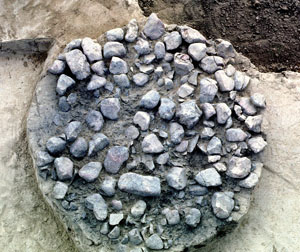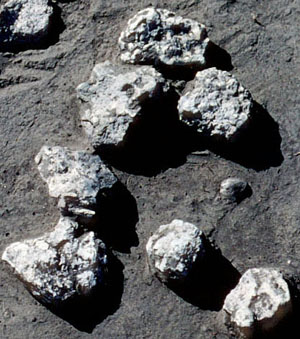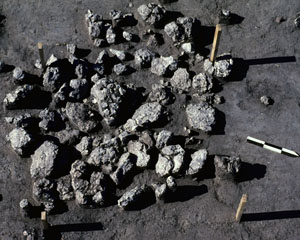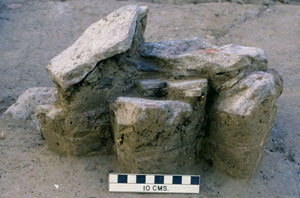Cook Stone
Throughout the Archaic and Late Prehistoric periods the peoples of the South Texas Plains used various methods of hot-rock cooking, a pattern that continued into early Historic times. The use of heated rocks for cooking foods, especially plant foods, is a continental-wide pattern recognized in virtually all areas were rocks were present. The plants foods that most require this sort of cooking are roots and bulbs. There are, however, other ethnographically documented hot-rock cooking methods including stone griddles, stone boiling, and earth ovens in which meats were baked.
The most typical pattern seen in archeological sites in the region are circular clusters of “burned” (heated or cooked) stone usually called “hearths.” Some of these are tightly packed pavements that likely represent hot-rock beds (heating elements) of earth ovens, as is increasingly recognized in many places in North America. In use such hot-rock beds would have been covered by layers of food and green plant materials for packing and steaming, capped by thick layers of earth. The upper layers are removed and displaced when the baked food is taken out hours or days later, thus leaving behind the undisturbed "hearth" pattern.
Cook stone resources in the South Texas Plains are varied in composition and availability. Nearing the coast, rocks disappear and sometimes baked clay was used instead. Elsewhere, rocks suitable for cook stone are present in most areas, but often of marginal quality for the task. There are calcium carbonates, tuff (poorly consolidated volcanic ash), sandstone (see Sandstone), and caliche, a very soft calcium carbonate that sometimes occurs in soft rock form (as opposed to crumbly earth). With exception of hard sandstone (and quartzite), none of these rocks are ideal cook stone. The ideal cook stone is a fairly hard, non-porous rock of uniform density with few internal flaws or strong bedding planes. The peoples of the greater Edwards Plateau found limestone to be an excellent cook stone (see Limestone). The metamorphic rocks (such as granite) of the Llano Uplift, by contrast, are poorly suited and used only in areas where no limestone was present.
The natives of the South Texas Plains used what they had access to. For example, the relatively soft tuffaceous bedrock of the Catahoula Formation that outcrops along the valley wall (upland edge) of Frio River valley in the Choke Canyon area. Fragments of tuff work, but not for long and not very well. Soft rocks don’t hold heat for long and they break apart quickly. In the Choke Canyon area, sandstone outcrops were preferred sources of cook stone, but they were not always near at hand. In several documented cases at Choke Canyon, for instance, at the Gates-Rowell site, river cobbles of chert in a basin-shaped “hearth” (an obvious hot-rock bed of an earth oven). This is peculiar because chert cobbles can violently break apart when introduced to a hot bed of coals. See Choke Canyon.
All across the South Texas Plains, because hearths and oven beds are common in campsites, albeit only in modest quantities compared to most sites in the Edwards Plateau and Lower Pecos Canyonlands. Common in those areas are the large piles of discarded baking stones known as burned rock middens—places where hot-rock cooking (earth oven baking) was carried out over and over. Burned rock middens are rare in the South Texas Plains, but do occur in a few places. For instance, several modest-sized burned rock middens were documented at Choke Canyon near sandstone outcrops. It is also the case that burned rock middens typical of the Edwards Plateau are present in the northern edge of the South Texas Plains, adjacent to the Plateau. There limestone is present, but neither the rocks nor the burned rock midden pattern goes very far south into the region.
Overall, the hot-rock cooking patterns of the South Texas Plains have not been well studied, in large part because of the lack of well-preserved buried sites. One suspects that interesting patterns of cook stone selection might be detected and linked to geological sources. We could predict that the better suited rock types would be favored, but exactly which these might be depends on what would have been locally available. Hunter-gatherers rarely lugged cook stone very far.
|
Close-up view of cook stone made of tuff, site 41LK67 at Choke Canyon. UTSA-CAR Archives. |
|
Close-up view of cook stone made of sandstone at the Boiler site along the Rio Grande near Laredo. UTSA-CAR Archives. |

Unusual hearth with most of the cook stone made up of chert. Gates-Rowell site at Choke Canyon. UTSA-CAR Archives. |


